10 Types of Hawks in Minnesota (Pictures)
Sharp talons, excellent eyesight, and the ability to move swiftly through the air makes hawks a dangerous bird of prey. But their movements are captivating, aren’t they?
If you have the same opinion and would like to see Hawks in action, time to give Minnesota a visit. Because there are 10 different species of hawks in Minnesota.
Learn how to identify these species by reading our article as we detail their every single feature here.
10 Species Of Hawks in Minnesota
Minnesota has ten types of hawks residing there. They all have unique features and characteristics that make them different from other hawks.
If you know all about their different distinguishable elements, you can quickly identify them.
1. Broad-winged Hawk (Buteo Platypterus)
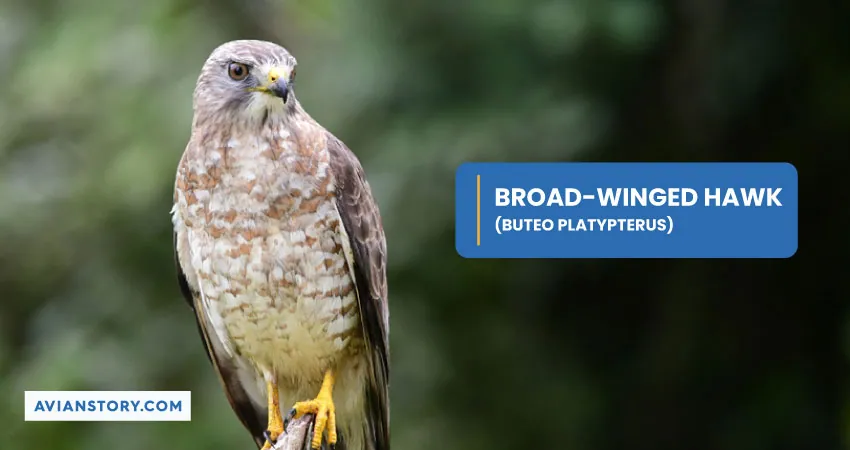
Broad-winged hawks breed only in Minnesota but do not choose any particular region for this. During the Fall and Spring season, you can find them at the edge of Lake Superior.
In the summer, they whistle a piercing sound, another marker for their identification.
Identifying Features
Mature broad-winged hawks are more significant than a crow but smaller than a goose. The male and female broad-winged hawks are similar in size, length, and wingspan.
Adult broad-winged hawks are moderately sized with sturdy bodies. The plumage on their feathers has a reddish-to-brown color, and their tail has black and white lines.
They have a whistling sound that can be heard throughout the summer. The younger ones are bright brown colored with rough stripes at the bottom and sides of their chest. Their tails are thinly joined at the edges.
The broad-winged hawks in the western region of Minnesota are dark brown to black and have a pitch-brown joint tail.
Food Habit
Their palate has a wide range from small mammals to reptiles to amphibians. In the case of mammals, they eat mice, squirrels, small rodents, etc.
From reptiles, these hawks prefer small turtles, lizards, and snakes. They like to feed on frogs and toads from amphibians.
Broad-winged hawks sometimes eat small worms such as earthworms, centipedes, etc.
Nesting Pattern
These preying birds prefer to build their nests at the lower portion of tall trees, about 25 to 50 feet above the ground. Broad-winged hawks usually build smaller nests consisting of manly sticks and twigs with a bed lining made from moss.
These birds also claim other birds’ nests as their own.
Mating and Incubation
During early breeding, these birds circle in pairs in the high sky, one male and one female, for their mating call. Then one of the birds flies higher and dives sharply toward the land.
Broad-winged birds usually lay from 1 to 4 birds at a time. The eggs have a white color with brown spots on them.
Only the female birds incubate the eggs for about 28 to 30 days. Male birds bring food during this time and help the female bird with incubation.
2. Cooper’s Hawk (Accipiter Cooperii)
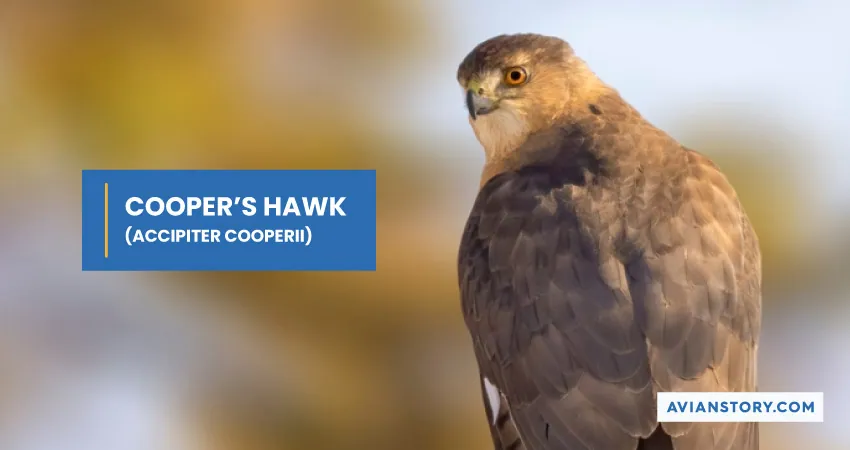
Cooper’s hawk can be found in Minnesota at any time of the year. They choose the southern part of Minnesota state for their breeding.
Identifying Features
A mature Cooper’s hawk’s size is the same as a crow’s. This hawk seems like they are an adult version of the sharp-shinned hawk.
But Cooper’s hawks are much larger than the sharp-shinned hawks. The female Coppers are comparatively bigger in length, weight, and wingspan.
Adult Cooper’s hawks are dark bluish-gray on the upper part. At the bottom, these birds have bright reddish lines and a thick black line on their tail.
Younger Cooper’s birds are brown at the uppermost part. This feature gives the juvenile Cooper’s hawks a hooded appearance.
Food Habit
Cooper’s hawks mainly feed on medium size birds and small mammals. They prefer birds that are similar in size to robins, flickers, and jays, and some larger and smaller birds as well.
From small mammals, Cooper’s hawks choose to eat mice, both tree and ground squirrels, bats, and chipmunks. The Cooper’s birds also prefer eating reptiles and insects such as snakes, lizards, small turtles, and worms.
Nesting Pattern
Coopers’ hawks choose to build their nests on sky-high trees such as coniferous or deciduous, and their preferred height is 25 to 50 feet above the ground.
Most of the time, Cooper’s hawks build their nest on top of formerly built nests of other birds and squirrels.
Both males and females contribute to building nests using bulky sticks and lining the nests with bark strips.
Mating and Incubation
Both sexes try to court one another during mating season by flying over the opposite sex’s territory. They fly very slowly during this time with prominent beats of their wings.
The males feed and take care of the females until she lays eggs.
Cooper’s hawks usually lay about 1 to 7 birds at a time. Their eggs have a light bluish-white color.
Females incubate the eggs for about 15 to 18 days. During this time, the male birds bring food to the female birds and help them by incubating the eggs.
3. Ferruginous Hawk (Buteo Regalis)
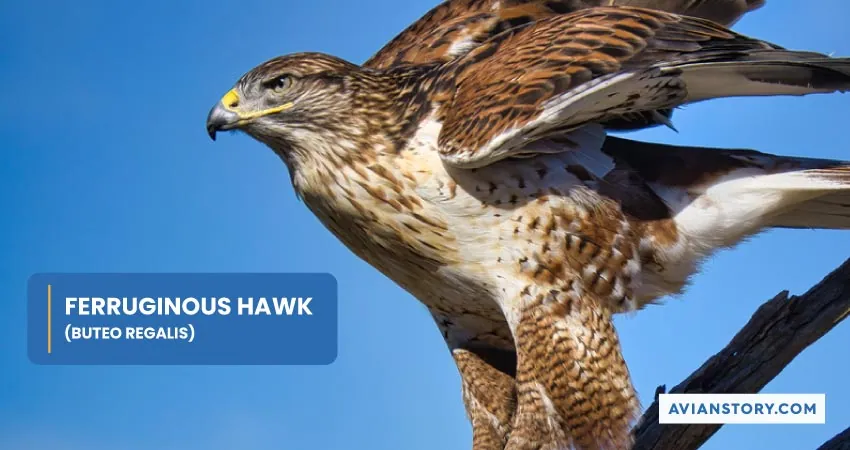
Ferruginous hawks can be found all over Minnesota. But notably, the western border of Minnesota is their preferred spot for breeding.
Identifying Features
Ferruginous Hawks are more extensive than a crow but smaller than a goose. Both the male and female sexes of Ferruginous Hawks have the same length, weight, and wingspan.
Ferruginous Hawks have two different well-defined distinctions: light morph and dark morph.
Light morphs of Ferruginous Hawk are extraordinarily white at their bottom. Their legs have a rusty color which turns into a V shape when the birds are flying.
Juvenile light morph Ferruginous Hawks are brown spots on their legs and stomach.
The dark morphs of Ferruginous Hawks are much rarer than light morphs. They are dark reddish chocolate colored.
The inner wing part has a white color that changes into white bars on the outer wing.
Food Habit
Ferruginous hawks eat primarily small to medium-sized mammals, birds, reptiles, and larger insects. They prefer to hunt the prey that is the most readily available.
Their carnivorous diet includes tree and ground squirrels, rabbits, gophers, rats, mice, cottontails, snakes, etc.
Nesting Pattern
Ferruginous Hawks prefer building their nests on tall trees 20 to 50 feet above the ground. If they can’t find a large tree, they choose the tallest tree near them and build their nest about 6 feet above the land.
Ferruginous Hawks also build their nest on grounds and edges of high cliffs.
They create a robust and bulky nest using sticks, twigs, and debris. Ferruginous Hawks line their nest using softer elements such as leaves, moss, and cow dung.
These hawks reuse nests of other birds and add materials to enlarge them.
Mating and Incubation
During the breeding season, both sexes of Ferruginous Hawks circle above each other’s territory with their distinct mating call. The female birds lay up to 6 eggs at a time.
And the eggs have a light blue color which fades to white and has brown markings on the surface.
Both male and female Ferruginous Hawks participate in incubating eggs, but the females contribute more. Incubation takes about 32 to 35 days.
During the incubation period, the male Ferruginous Hawks feed the female hawks.
4. Northern Goshawk (Accipiter Gentilis)
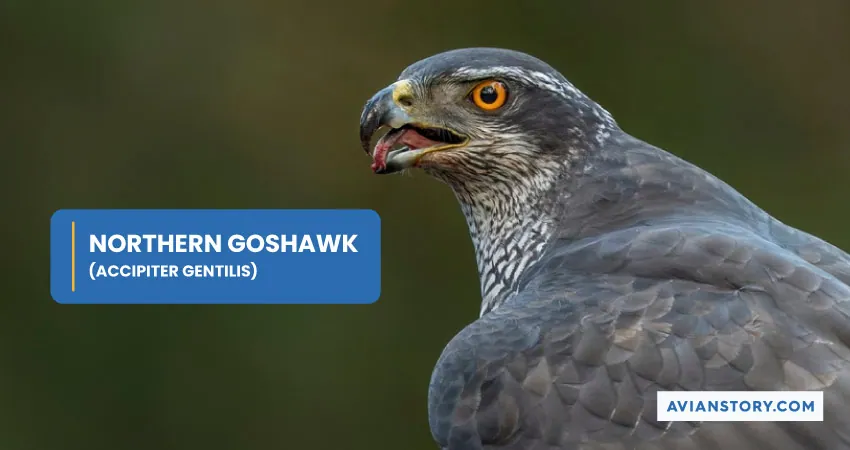
The northern part of Minnesota is populated with northern goshawks. They are very hard to find in a busy area.
If you go into a forest and do not make any sound, you might be able to find them.
Identifying Features
An average Northern Goshawk is smaller than a goose but larger than a crow. Both males and females have the same length, weight, and wingspan.
However, the female birds are nearly similar in size to a red-tailed hawk. In contrast, the male Northern Goshawks are somewhat bigger than a female Cooper’s hawk.
Mature Northern Goshawks are dark gray on the top and have light gray lines on the bottom. Their head has a dark color with white lines around the eye.
The color of their eyes ranges from orange to red.
And the immature or juvenile Northern Goshawks have brown bodies with streaks between them. Their tails are tapered with dark lines on them.
Younger Northern Goshawks have distinguishable light eyebrows and yellow eyes.
Food Habit
Northern Goshawks’ diet consists of various-sized birds and small mammals. They like to hunt for crows and grouse.
These hawks select rabbits, squirrels, mice, and rats from small mammals. Northern Goshawks also like to include snakes and other insects, such as worms and centipedes, in their diet.
Nesting Pattern
Northern Goshawks choose large and tall trees, such as deciduous trees in forests, for their nests. They build their nests on a large space in the truck, usually above 25 to 50 and sometimes 75 feet above the land.
Females mainly build nests using sticks with green leaves for soft bedding. Northern Goshawks reuse their nests by adding new building materials to keep their nest sturdy.
Mating and Incubation
These hawks mate for life. In the mating period, adult Northern Goshawks fly over the nests of the opposite sex by circling in a glide.
During flying, the bird spreads its tail with fluffy white feathers in an attractive display. Then they dive down and fly up a few times in quick succession.
Northern Goshawks lay 2 to 4 eggs, sometimes five eggs at a time. Their eggs have a light blue color which seemingly fades to white.
The female Northern Goshawk incubates the egg for 35 to 40 days. Meanwhile, the male Northern Goshawk brings food and feeds the female bird during this time.
5. Northern Harrier (Circus Hudsonius)
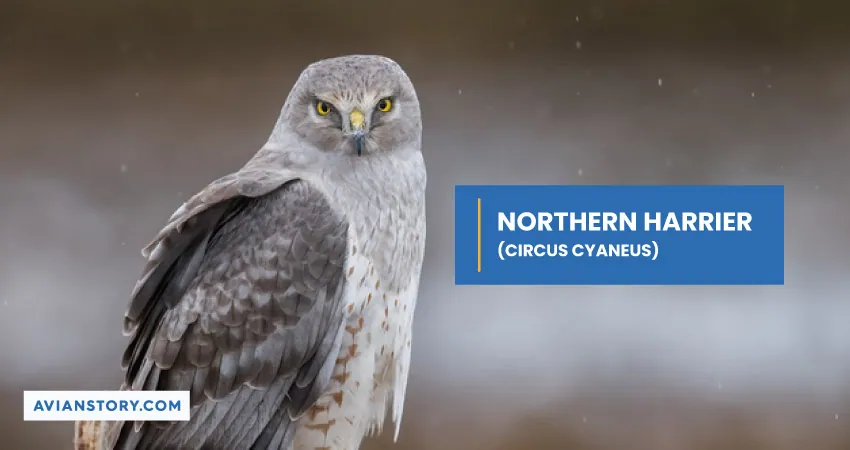
This hawk can be found in Minnesota’s northern and central regions during breeding time. During the non-breeding season, you can find them all over the state.
In winter, they choose to migrate to the southeast region of Minnesota.
Identifying Features
Northern Harriers are smaller than a goose but larger than a crow. More specifically, they are larger than a Sharp-shinned hawk but smaller than a red-tailed hawk.
Like most other hawks, both female and male Northern Harriers have the same length, weight, and wingspan.
Male and female Northern Harriers have distinctive body patterns. The male Northern Harrier is gray on top of its body and has a black joint tail.
They are white on the bottom, and their wing edges are black with dark lines.
Female Northern Harriers are white on the bottom with brown lines and have black bands on their tails. Immature Northern Harriers are also brown with a black banded tail.
However, they are yellowish brown on the bottom and have fewer streaks.
Every Northern Harrier has a white patch on its back which is more prominent during their flying period.
Food Habit
These hawks primarily feed on birds and small mammals. Their diet depends on their location and the season. Northern Harriers like to eat rats, small rodents, voles, and rabbits.
This includes birds as well, such as doves, ducks, flickers, and songbirds. Northern Harriers also eat grasshoppers and other insects, lizards, frogs, toads, and snakes.
In the winter, they prefer to eat carrion.
Nesting Pattern
Unlike most other hawks, Northern Harriers build their nests on land in thickly covered fields and wooded areas. They build their nest in separate colonies.
The female Northern Harriers mainly build the nests while the males supply the building materials. They use sticks, twigs, grass, and weeds to build their nests.
Mating and Incubation
The male Northern Harriers court the female birds. Males fly up and dive down repeatedly during the breeding season.
The female birds lay either 4 to 6 eggs at a time or 2 to 7 eggs at a time but never more. Their eggs are light blue, fading to white with stained marks from the nest and light brown spots.
Only the female birds incubate for 30 to 35 days. After the eggs hatch, the male fetches food and feeds the female bird.
6. Red-shouldered Hawk (Buteo Lineatus)
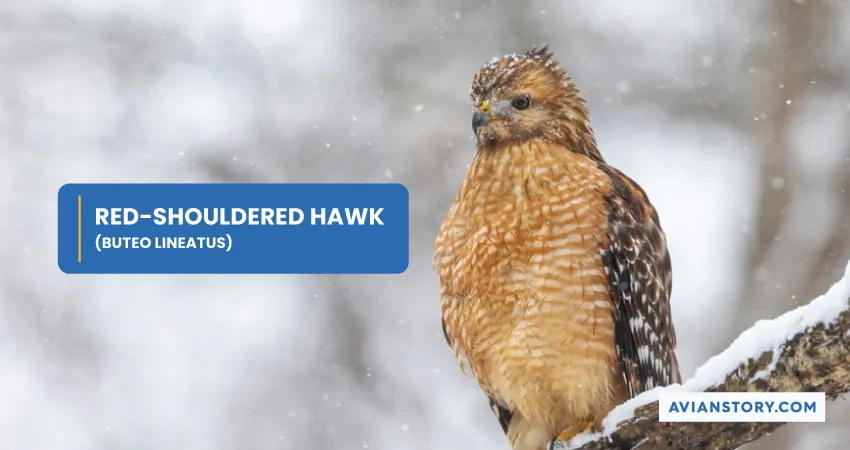
Red-shouldered hawks mainly breed in the central region of Minnesota. They can be found near the eastern region of Minnesota, and sometimes they fly to California.
In the last 50 to 60 years, their number has increased proportionally.
Identifying Features
Red-Shouldered Hawks have medium-sized bodies with circular wings and moderately sized wings. They soar using the tips of their wings and form a particular reaching pose.
These hawks are larger than an average crow but smaller than a goose. Compared with other hawks, they are bigger than a broad-winged hawk but smaller than a red-tailed hawk.
Both males and females are similar in length, weight, and wingspan.
Adult Red-Shouldered Hawks have dark and light mixed wings. Their chests have red stripes, and their tail is black colored with short white lines.
Immature Red-Shouldered Hawks are brown on the top and white with brown streaks on the bottom. All ages of Red-Shouldered Hawks have short, light crescents by the edge of their wings.
Food Habit
Red-Shouldered Hawks’ diet consists of reptiles, amphibians, small mammals, and birds. From mammals, they prefer voles, rats, rabbits, and chipmunks.
Red-Shouldered Hawks select frogs, toads, and crayfish from the amphibians for their food. They also eat snakes, insects, and sometimes fish but rarely eat carrion.
Nesting Pattern
Red-Shouldered Hawks make their nests in deciduous trees and conifers. They find a space in the trunk or branches with the trunks to build their nests, usually above 40 to 70 feet off the ground.
Both males and females participate in building the nests using sticks, bark, moss, and other green vegetation. Like most other hawks, Red-Shouldered Hawks recycle their nests by adding more materials to make them stronger.
Mating and Incubation
To court the females, the male Red-Shouldered Hawks soar up and glide down while calling for the females. Then both the male and female fly together in a circle over their territory.
Red-Shouldered Hawks lay 3 to 4 eggs at a time. The eggs are light blue, fading to white with brown and lavender blotches on the surface.
Mainly the female incubates the eggs for up to 35 days. During this period, the male birds bring food for the female Red-Shouldered Hawk and help them incubate.
7. Red-tailed Hawk (Buteo Jamaicensis)
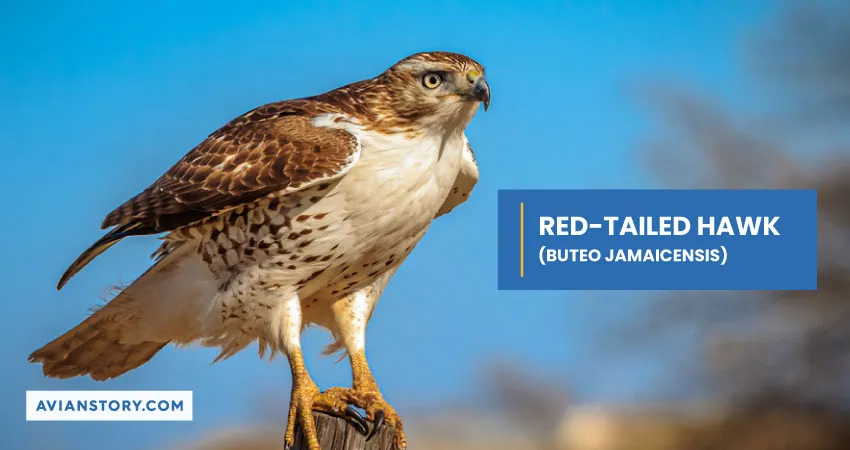
Red-tailed hawks are the most commonly found hawk in Minnesota and the USA. Around 90% of the total red-tailed hawks in the world reside in Minnesota.
They prefer to breed in the northern region of Minnesota state.
Identifying Features
Red-Tailed Hawks are the second largest hawk, the first being the Ferruginous Hawk. They are wide with circular wings and have a narrow, broad tail. Large females might look like an eagle due to their size.
These hawks are larger than a crow but smaller than a goose. Females and males have the same wingspan, but the female Red-Tailed Hawks are bigger and heavier than the males.
Red-Tailed Hawks are deep brown on their top part and pale brown on the bottom. They have dark streaks on their stomach and underneath their wings.
There is a dark line between their shield and legs. Their tail is light brown on the bottom and brownish red on the top.
Juvenile Red-Tailed Hawk has banded tails of brown color.
These have two distinct morphs: dark morphs and rufous morphs. The dark morph Red-Tailed Hawks are dark brown with bright red tails. Rufous morph birds are brown on the breast and have dark stomachs.
Food Habit
Red-Tailed Hawks have a diverse palate. They eat small mammals, reptiles, amphibians, and birds. Their diet changes from location to location and season to season.
Red-Tailed Hawks eat mainly land squirrels along with rats, voles, and rabbits. They also prey on pheasant birds, snakes, frogs, bats, toads, insects, and sometimes carrion.
Nesting Pattern
Red-Tailed Hawks build their nests in many places. It could be on top of a tree and 120 feet off the ground.
But it also could be on cliff edges, giant cacti, or large towers and buildings.
Both males and females participate in building the nests. They use sturdy sticks with leafed branches for a soft bed lining.
Mating and Incubation
During their courtship, male and female Red-Tailed Hawks fly high in the sky in circles with sharp cries. Male birds fly high and suddenly dive low and catch prey for females.
Red-Tailed Hawks lay 2 to 3 or 4 or sometimes 1 to five eggs. Their eggs are white with brown spots on the surface.
Both males and females incubate the eggs for 30 to 40 days.
8. Rough-legged Hawk (Buteo lagopus)
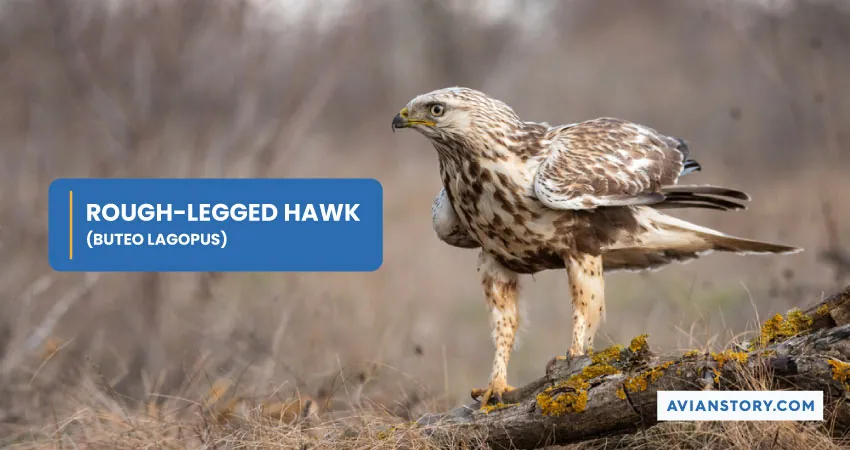
Rough-legged hawks have a non-breeding category. During the winter, they migrate and breed all over Minnesota. They migrate to Alaska and Canada as well in every season for breeding.
Identifying Features
Rough-Legged Hawks are comparatively larger and have wide, large wings, which are long and slender. Their wingtips are wide, swept back from the wrist, giving them an M shape. They have a bill that is quite smaller than other hawks.
These hawks are larger than an average crow but smaller and less substantial than a red-tailed hawk. Rough-Legged Hawks are smaller than a goose as well. Both males and females have the same length, weight, and wingspan.
Rough-Legged Hawks are dark brown with prominent patterns, and their tails are dark at the edge but light at the bottom. This hawk has a light and dark morph, like many other hawks.
Light morph hawks are light-colored beneath the wings and have dark patches at the wing fold. Females have bright heads and dark spots on their stomachs, whereas males are slightly faded-colored.
Dark morph hawks are, most of the time, rich brown. But the bottom of their wings has light brown spots.
Food Habit
Rough-Legged Hawks’ diet mostly consists of various types of rodents. They prefer to eat mainly lemmings and voles. During summer, lemmings consist of almost 80% of their diet.
They also eat many birds, mice, and squirrels. If they can, Rough-Legged Hawks feed on small mammals and various birds, insects, toads, and frogs. In winter, they prefer to eat carrions.
Nesting Pattern
Rough-Legged Hawks build their nests on small ledges and the edges of high cliffs. They also build their nests on tree slopes, on top of huge rocks, and sometimes on the ground.
Rough-Legged Hawks use sticks, debris, and bones of animals with grassed and twigged bedding to build a long-lasting nest.
Mating and Incubation
During the breeding period, Rough-Legged Hawks fly around together in a circle.
Then they execute a special mating dance by soaring high and diving low. Rough-Legged Hawks lay 3 to 5 eggs or 2 to 6 eggs at a time. If they have an abundance of food, Rough-Legged Hawks might lay even more eggs at a time.
Their eggs are light blue, fading to white with violet and brown spots on them. Only female Rough-Legged Hawk participate in incubation for 30 to 35 days.
The male birds bring food for the female Rough-legged Hawks during this time.
9. Sharp-shinned Hawk (Accipiter Striatus)
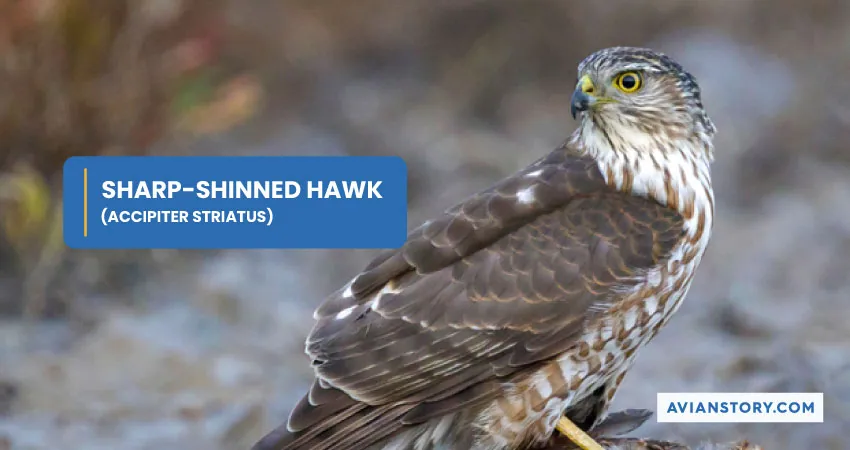
Sharp-shinned hawks can be found all over Minnesota. During the winter, they migrate to Alaska and Canada to continue breeding.
If you want to see non-breeding shinned hawks, you can find them in southern and central Minnesota.
Identifying Features
Sharp-Shinned Hawks are comparatively smaller than most other hawks, with a long tail but narrow, circular wings. Their heads are quite small and do not protrude beyond the wing wrists.
Sharp-Shinned Hawks’ tails are tipped in a square shape with a notch. Female Sharp-Shinned Hawks are significantly larger than males.
Male Sharp-Shinned Hawks are similar in size to kestrels and bigger than jays. Female hawks are almost the same size as male Cooper’s hawks.
Sharp-Shinned Hawks are larger than a robin but smaller than a crown.
Mature Sharp-Shinned Hawks are bluish-gray on the top and have a short reddish-orange line on their chest. Juvenile Sharp-Shinned Hawks are primarily brown and thick brown streaks on the bottom.
Both mature and immature Sharp-Shinned Hawks have wide dark lines along their long tails.
Food Habit
The diets of Sharp-Shinned Hawks mostly consist of small birds. They prefer birds from a sparrow’s size to a robin’s size.
These birds also eat rodents, squirrels, bats, lizards, snakes, frogs, and insects.
Nesting Pattern
Sharp-Shinned Hawks build their nests in a secluded conifer tree about 20 to 60 feet above the land. They choose forests and dense grooves overcrowded areas.
Sometimes they build their nest by replacing the nest of another bird or a squirrel. Both male and female Sharp-Shinned Hawks build nests using sticks, twigs, barks, and grass.
Mating and Incubation
During the mating season, Sharp-shinned Hawks circle in a glide over the nests of the opposite sex. The bird makes a lovely flying spectacle by spreading its fluffy white tails.
Then they quickly alternate between diving down and flying up several times.
Sharp-Shinned Hawks lay 4 to 5 eggs at a time, and very rarely, they lay 1 to 6 eggs at a time. Their eggs are light blue with a white undertone and have brown splotches on top.
The female Sharp-Shinned Hawks mainly incubate the eggs for 30 to 35 days. During the incubation period, males bring food and help the female with incubation.
10. Swainson Hawk (Buteo Swainsoni)

Swainson hawk has a wide breeding range from the western to southern parts of Minnesota. You can easily find them in September and April flying around as they come out of breeding during this time.
Identifying Features
Swainson’s Hawks are quite large, with extensive wings and narrow tails. They are thinner than most other hawks.
These hawks have long wings, which form a V shape when flying. They are bigger than Cooper’s hawk and a crow but smaller than a goose and a Ferruginous hawk.
Swainson’s Hawks have a light brown stomach with a dark brown colored chest, and their upper body is either gray or brown. Under the wings, they have white bars but dark black feathers.
Males Swainson Hawks’ heads are grey, whereas female Swainson Hawks’ heads are brown. Dark Swainson’s Hawks have color that varies from red to pitch black with light color underneath the wings.
Food Habit
Swainson’s Hawks eat reptiles, small mammals during the summer, and other large insects in other seasons. Their diet includes gophers, squirrels, mice, lizards, snakes, bats, small birds, and carrion.
They also feed on grasshoppers, caterpillars, dragonflies, and various worms.
Nesting Pattern
Swainson’s Hawks nest in tall trees or shrubs in open areas, cliff edges, and slopes. Their nests are about 15 to 300 feet off the ground.
This bird also builds its nest on top of other birds’ nests. Swainson’s Hawks use sticks, twigs, weeds, and green leaves to build their nest.
Mating and Incubation
During the breeding season, both male and female Swainson’s Hawks fly together in a circle with sharp dives in between. They lay 2 to 3 eggs or 1 to 4 eggs simultaneously.
Their eggs are light blue with brown spots on the surface. Female birds incubate the eggs for 30 to 35 days. During this time, the fathers bring food for the mother birds.
Species Profile
Here is a list of all ten hawks and their various physical and observable qualities.
| Name | Length | Weight | Wingspan | Commonly Found In | Behavior | Interesting Fact |
| Broad-Winged Hawk | 13.5 to 17.5 inches | 9.5 to 20 oz | 32 to 39.5 inches | Forest with conifers and deciduous trees | Lone-wolf and territorial | Migrate in spiraling flocks |
| Cooper’s Hawk | Male: 14.5 to 15.5 inches Female: 16.5 to 18 inches | Male: 1.5 to 14.5 oz Female: 11.5 to 24 oz | Male: 24.5 to 35.5 inches Female: 30 to 35.5 inches | Forest, woodlot, woodland, mountain | Aggressive toward opponent | Males and females are of different sizes |
| Ferruginous Hawk | 22 to 27 inches | 34.5 to 73 oz | 52.5 to 56 inches | Grassland, woodland, prairie, scrubland | Unafraid of humans, allow approach | Have feathered legs down to toes |
| Northern Goshawk | 21 to 25 inches | 22.5 to 48 oz | 40.5 to 46 inches | Mixed and coniferous forests | Fierce, defensive, attack easily | A single member of its genus found in both North America and Eurasia |
| Northern Harrier | 18 to 20 inches | 10.5 to 27 oz | 40 to 46.5 inches | Tundra, marsh, grassland, prairie | Hunt in open regions. Depend on vision and hearing to hunt. | Owl-like hawk |
| Red-Shouldered Hawk | 17 to 24 inches | 17 to 27.5 oz | 37 to 44 inches | Fields and deserts | Territorial and solitary | Migrate alone |
| Red-Tailed Hawk | 17.5 to 22.5 inches | 24.5 to 46 oz | 45 to 52.5 inches | Park, field, woodland, desert | Grouped and territorial | Eyesight eight times better than human’s |
| Rough-legged Hawk | 18.5 to 20.5 inches | 25 to 49.5 oz | 52 to 54.5 inches | Desert, prairie, field, airport, the arctic | Aggressive during migration | Have feathered legs down to toes |
| Sharp-Shinned Hawk | 9.5 to 13.5 inches | 3 to 8 oz | 17 to 22 inches | Forest and edge of a forest | Call, chase, and attack intruders | Smallest hawk in Northern America |
| Swainson’s Hawk | 19 to 22 inches | 24.5 to 48.5 oz | 45 to 55 inches | Grasslands | Hunt using foot | Longest migrants in North America. Migration lasts at least two months |
Final Words
As you cans see, you can find a total of ten different types of hawks in Minnesota.
You have higher chances of finding some of these species, such as red-tailed and broad-winged hawks, than species like ferruginous hawk. But if you try, it is possible to find all of them.
Resources
- https://www.birdadvisors.com/hawks-minnesota/
- https://birdfact.com/articles/hawks-in-minnesota
- https://www.birdsadvice.com/hawks-in-minnesota/
Feature Image Credits: Casey Ray Photography, Shutterstock
